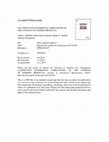Papers by Allegre L Hadida

International series in management science/operations research, 2023
We study the conditions that influence judgmental forecasting effectiveness when predicting deman... more We study the conditions that influence judgmental forecasting effectiveness when predicting demand in the context of fashion products. Human judgment is of practical importance in this setting. Our goal is to investigate what type of decision support, in particular historical and/or contextual predictors, should be provided to human forecasters to improve their ability to detect and exploit linear and nonlinear cue-criterion relationships in the task environment. Using a field experiment on new product forecasts in the music industry, our analysis reveals that when forecasters are concerned with predictive accuracy and only managerial judgments are employed, providing both types of decision support data is beneficial. However, if judgmental forecasts are combined with a statistical forecast, restricting the decision support provided to human judges to contextual anchors is beneficial. We identify two novel interactions demonstrating that the exploitation of nonlinearities is easiest for human judgment if contextual data are present but historical data are absent. Thus, if the role of human judgment is to detect these nonlinearities (and the linearities are taken care of by some statistical model with which judgments are combined), then a restriction of the decision support provided would make sense. Implications for the theory and practice of building decision support models are discussed.
Cambridge University Press eBooks, 2013

Journal of the Academy of Marketing Science, Oct 2, 2017
Across the many studies of motion picture box office success, unresolved debates and untested ass... more Across the many studies of motion picture box office success, unresolved debates and untested assumptions about the contributing factors persist. Using an accessibility-diagnosticity framework and a meta-analysis of 634 effect sizes from 150 studies, the current article seeks to clarify the relationships of star brand equity and product reviews (from consumers and critics) with box office success. The popularity of stars (market and media appeals) exerts a stronger impact on box office success than their artistic recognition (as per award nominations and wins) at the moment of a movie's release but not over its extended theatrical run. Whereas the impact of popular stars on box office success decreases over time, the influence of artistically recognized stars remains steady. The findings also identify a dual role for critics, who influence consumers' movie choice and predict box office performance by merely reflecting moviegoers' tastes. Finally, this study refutes the assumption that the impact of users' reviews strengthens over time, relative to critics' reviews.
Cambridge University Press eBooks, 2013

International Studies of Management and Organization, 2005
This paper examines the influence of the complex interactions of the institutional environment, g... more This paper examines the influence of the complex interactions of the institutional environment, governance structures, and strategic assets on the creation and maintenance of the competitive advantages of leading firms. It introduces an original theoretical model combining the two complementary approaches of the new institutional economics (institutional environment and institutions of governance) with the resource-based view (strategic asset endowment of firms). This model is then used to investigate why French cinema gained and reinforced an initial competitive advantage over its U.S. counterpart from 1895 to 1914. Our findings show that a more favorable institutional environment explains the initial French advantage from 1895 to 1907. A culture of mutual forbearance between members of the elite combined with low levels of patent protection influenced the leading French cinema companies to concentrate on the creation of strategic assets such as supplies and studio facilities. Inside an environment of fierce competition and strong patent protection, U.S. cinema companies developed legal assets for patent wars on equipment. More economizing governance choices and contractual innovations by French firms at home and abroad reinforced the French advantage between 1908 and 1914. U.S. firms developed institutional assets to negotiate and enforce private cartels to the detriment of distribution assets. Later, U.S. antitrust law and conflicts of interests between cartel members influenced the emergence of independent U.S. firms with a strategic focus on cinema production and distribution assets. Ultimately, U.S. formal institutions reduced the transaction costs of local printed-film producers and provided more socially efficient forms of regulation than private cartel arrangements.
Management des industries culturelles et créatives, 2015
Handbook of Cultural Economics, Third Edition, 2020

Research Papers in Economics, 1993
Les entreprises artistiques et culturelles, au-dela des finalites qui leur sont propres, sont aus... more Les entreprises artistiques et culturelles, au-dela des finalites qui leur sont propres, sont aussi des organisations. A ce titre, elles relevent du management et celui-ci peut leur apporter une efficacite accrue dans la poursuite de leurs objectifs specifiques ; reciproquement elles peuvent aussi etre sources d'innovations generalisables a d'autres secteurs. L'objet de ce livre, fonde sur les enseignements developpes par les auteurs dans le cadre d'une option specialisee de l'Ecole HEC (MAC, Management des Arts et de la Culture), est de faciliter la comprehension reciproque et de contribuer au rapprochement de l'art et du management en fournissant aux responsables d'entreprises artistiques et culturelles une vue d'ensemble du management et de ses principales composantes : politique generale, marketing, gestion des ressources humaines, droit et fiscalite, finance et controle de gestion. L'ouvrage s'adresse a l'ensemble des " managers ...
This paper introduces a framework derived from the resource-based view to investigate the impact ... more This paper introduces a framework derived from the resource-based view to investigate the impact of reputation resources and commitment on commercial and artistic performance of film projects. Structural models are tested on 2080 films first released in American theatres from 1988 to 1997. Results demonstrate the mediating role of financial commitment in assessing film performance and in transforming static resources into dynamic assets. They unearth a novel hierarchy and dynamics of primary resources and irreversible commitment and of key players in a film project: Actors first, then directors and producers in a coordinating role. Third, they confirm industrial rather than artistic dominant traits of American cinema.

Journal of the Academy of Marketing Science, 2017
Across the many studies of motion picture box office success, unresolved debates and untested ass... more Across the many studies of motion picture box office success, unresolved debates and untested assumptions about the contributing factors persist. Using an accessibility-diagnosticity framework and a meta-analysis of 634 effect sizes from 150 studies, the current article seeks to clarify the relationships of star brand equity and product reviews (from consumers and critics) with box office success. The popularity of stars (market and media appeals) exerts a stronger impact on box office success than their artistic recognition (as per award nominations and wins) at the moment of a movie's release but not over its extended theatrical run. Whereas the impact of popular stars on box office success decreases over time, the influence of artistically recognized stars remains steady. The findings also identify a dual role for critics, who influence consumers' movie choice and predict box office performance by merely reflecting moviegoers' tastes. Finally, this study refutes the assumption that the impact of users' reviews strengthens over time, relative to critics' reviews.

Journal of Marketing, 2018
Increasingly, marketing activity is carried out within temporary organizations, whereby teams are... more Increasingly, marketing activity is carried out within temporary organizations, whereby teams are assembled to complete a specific task within a predetermined time frame. Such organizations are uniquely suited to promoting various marketing outcomes but are not well understood. From a practical standpoint, their inherent characteristics create organizational challenges that, if not appropriately managed, can compromise performance. Drawing on agency theory and research on embedded ties, the authors conceptualize these challenges in terms of particular selection and enforcement problems. They identify three forms of temporary marketing organizations that vary in their selection and enforcement qualities. Next, the authors develop a conceptual framework that shows the selection and enforcement implications of a temporary organization’s task, timeline, and team composition. They also demonstrate that selection and enforcement mechanisms have portable qualities and can be “imported” to ...

Journal of Cultural Economics, 2020
Online streaming services are challenging long-standing decision-making processes in the traditio... more Online streaming services are challenging long-standing decision-making processes in the traditional motion picture industry, thus placing Hollywood major studios at a crossroads. We use the institutional logics perspective to examine how both traditional studios and online streaming services make strategic decisions on which films to produce and how these films are to be distributed. We then apply scenario analysis to explore how their interaction will likely evolve. We argue that the key criteria that studio executives use to make production and distribution decisions are shaped by what we define as a commitment institutional logic: decision-making heuristics that focus their attention on theatrical release and box-office intakes. In contrast, online streaming services follow a convenience institutional logic, the product of advanced data analytics to increase subscriptions. In the convenience institutional logic, the need to drive online traffic by providing users with an extensi...
Journal of Business Research, 2016
This article analyzes the effects of logic combination on cultural entrepreneurs' performance in ... more This article analyzes the effects of logic combination on cultural entrepreneurs' performance in both their original (artistic) and new (business) occupational communities. An analysis of the impact of the director-producer logic combination on artistic and commercial performance in French cinema confirms an asymmetry in outcomes: (1) although performance in the original artistic community is impaired by repeated logic combination (receiving less awards), (2) performance in the new business community benefits from logic combination (increased box office returns) as long as directors remain close to the boundary separating their original and new occupational communities.
Harvard Business Review, 2013
The article notes political analyst Nate Silver's book "The Signal and the Noise" a... more The article notes political analyst Nate Silver's book "The Signal and the Noise" and focuses on research that examined human and computer predictions for hit songs on the Top 100 popular music charts in Great Britain and Germany. The study found statistics-based computer software was more accurate in forecasting hit songs than the 180 people in the study. It also found a mix of human and computer predictions produced the best forecasts. Research methods in the study are noted.
This paper uses neo-institutional economics (I.E.) to examine why French film production firms ha... more This paper uses neo-institutional economics (I.E.) to examine why French film production firms have lost their competitive advantage to their American competitors from 1895 to 1998. I.E. posits that major institutional changes result in changes in firms' strategic assets and strategies as well as in strategic industry factors. This causal path represents a bold shift in perspective from Industrial Organization,
Academy of Management Proceedings, 2009
Drawing on empirical data from the music industry, we test the effectiveness of intuition in aggr... more Drawing on empirical data from the music industry, we test the effectiveness of intuition in aggregated model-manager predictions. Results demonstrate the value of expert intuition in ambiguous con...

Oxford Handbooks Online, 2013
Self-concept that describes employee behavior at work called self-evaluation can affect performan... more Self-concept that describes employee behavior at work called self-evaluation can affect performance and competitive advantage. This study aims to analyze the influence of self-evaluation (self-esteem, self-efficacy, locus of control, and self-monitoring) of the performance's creative industry. The study used creative population industries. Sample researches were 40 persons as a manager or owner creative industry, proportional random sampling. The instrument test used validity and reliability test. Data were analyzed using multiple linear regressions were subsequently tested hypothesis by the F test and t-test. Based on multiple regressions analysis of the F test and t-test show that self-evaluation (self-esteem, self-efficacy, locus of control, and self-monitoring) simultaneously and partially have a positive and significant effect on performance of creative industry. No research was found on self-evaluation of the performance of creative industry entrepreneurs. Government policies in providing a sense of business security and training of creativity are urgently needed by creative industry players to face competition in imported products.











Uploads
Papers by Allegre L Hadida